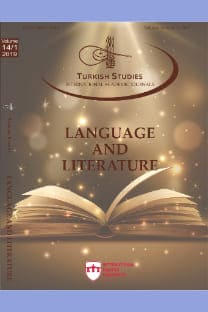Repetition and Contribution to Poetic Excitement in Poetry, The Example of Baudelaire
Repetition and Contribution to Poetic Excitement in Poetry, The Example of Baudelaire
___
- Acarlıoğlu, A. (2002). L’Espace répetitif dans le Chercheur d’Or de J.M.G. Le Clézi. Frankofoni Ortak Kitap, 14, 175-190.
- Alkan, E. (1995). Şiir Sanatı. Yön Yayıncılık.
- Baldıran, G. (1995). Alman işgali (1940-1944) ve Paul Eluard. Frankofoni Ortak Kitap, 7, 237- 245.
- Baudelaire, C. (1964). Les Fleurs du Mal. Çeviren: Ahmet Necdet. Dharma Yayınevi.
- Baudelaire, C. (1964). Les Fleurs du Mal. Garnier Flammarion.
- Baudelaire, C. (1961). OEuvres Complètes. Editions Gallimard.
- Bülbül, M. (2017). İmgesel İletişim. Çizgi Yayınları.
- Cohen, J. (1966). Structure du Langage Poétique. Flammarion.
- Crepin, F. et M. Loridon. et E. P. Damon Méthodes et Techniques, Nathan. Dubois, J. (1989). Dictionnaire Français. Larousse.
- Fontanier, P. (1977). Les Figures du Discours. Flammarion.
- Greiımas, A.J. & Courtes, J. (1979). Dictionnaire Raisonné de la Théorie du Langage. Hachette.
- Genç, N. (2010). Bir erkek, bir kadın iki aşk: Marguerite Duras’ın ayrılık müziği. Frankofoni Ortak Kitap, 22, 67-80.
- İnal, T. (1998), Zaman açgözlü düşman. Frankofoni Ortak Kitap, 10, 89-95.
- İşler, E. (2010). Farklı bir Orphée öyküsü: Anouilh’in Euridice’i. Frankofoni Ortak Kitap, 22, 111- 117.
- Richer, J. (1953). Paule Verlaine. Editions PS.
- ISSN: 2667-5641
- Yayın Aralığı: 4
- Başlangıç: 2006
- Yayıncı: ASOS Eğitim Bilişim Danışmanlık Otomasyon Yayıncılık Reklam Sanayi ve Ticaret LTD ŞTİ
Mahmud KADDUM, Mohamed Yazid SALEM
Changes Of Cultural Elements In Translation Works In Historical Processes And Re-Translations
Kırgız Türkçesinde Duygu Fiillerinin Semantik Yapısı ve Etimolojisi Üzerine Bir İnceleme
Muhammed Ali İsmail FAKİRULLAHOĞLU
Sufi Calligrapher in Visoko, Bosnia-Herzegovina: Huseyin Zilko Efendi and His Cönk
Sennur Sezer’in Şiirlerinde “Su” İmgesi
Elazığ Halk Kültüründe Ölüm Gelenekleri
Modern Özbek Hikâyelerinde Kadın Ruhunun Tasviri
